Yogic Breathing
As published in Sahapedia; also available in PDF with diacritics (and in Spanish here)
PRANAYAMA
By Daniel Simpson1
Control of the breath is one of the earliest recorded forms of yogic practice. It was described by the Buddha, who talked about trying it before his awakening 2,500 years ago. And although it is not taught explicitly in the Vedas, India's oldest texts, they do equate breath with the vital energy known as prana, which is related to fire in Vedic rituals.
A rationale for manipulating breathing is explained in the pre-Buddhist Chandogya Upanishad (6.8.2). A sage tells his son: "Just as a bird tied by a string flies off in all directions and, on not reaching any other place to stay, returns to where it is tied, in the very same way, dear boy, the mind flies off in all directions and, on not reaching any other place to stay, returns to the breath. For the mind, dear boy, is tied to the breath."2
A few centuries later, the Mahabharata names two yogic techniques of meditation: "one is the concentration of the mind, and the other is called pranayama," regulation of breath (12.294.8).3 The latter is "conditioned" (saguna), using breathing to steady the mind. The first is "unconditioned" (nirguna), refining awareness to focused oneness. The two are combined in the Bhagavad Gita (5.27), which mentions: "fixing the gaze between the two eyebrows [and] equalising the inhalation and exhalation."4
Pranayama is a compound of prana and ayama, which can indicate "extension" but mostly means "restraint" in yogic texts. For example, in Patanjali's Yogasutra (2.49): "Breath-control is stopping the flow of inhalation and exhalation."5 Elsewhere in the Patanjalayogashastra, a compilation of his sutras and commentary, he adds (1.34): "[mental steadiness] may also result from the exhalation and retention of breath."6 An unidentified verse is also quoted (2.52): "There is no austerity superior to breath-control. It results in the cleansing of impurities and the illumination of knowledge," which helps to facilitate liberation.7
Later texts teach breath-based ways of raising energy. The ultimate goal remains the same: removing obstacles to getting absorbed in meditation. The 15th-century Hathapradipika (2.75) says breath-control with kumbhaka — or "retention" — is the key to this, and therefore to mastering physical yoga. In contrast to the modern fixation on bodily postures, the defining practice in traditional texts is pranayama.
EARLY PRELIMINARIES
References to prana date back 3,500 years, to Vedic ritual. There are instructions for priests to hold their breath while reciting chants in the Jaiminiya Upanishad Brahmana (3.3.1). The Rig Veda (10.136) also mentions a cryptic "long-haired ascetic," or keshin, who "sails through the air" as if riding the wind by controlling breath.8 The Atharva Veda (11.4) pays homage to prana as the basis of life. "Breath is lord of all, both what breathes and what does not," it says. "In breath is all established."9
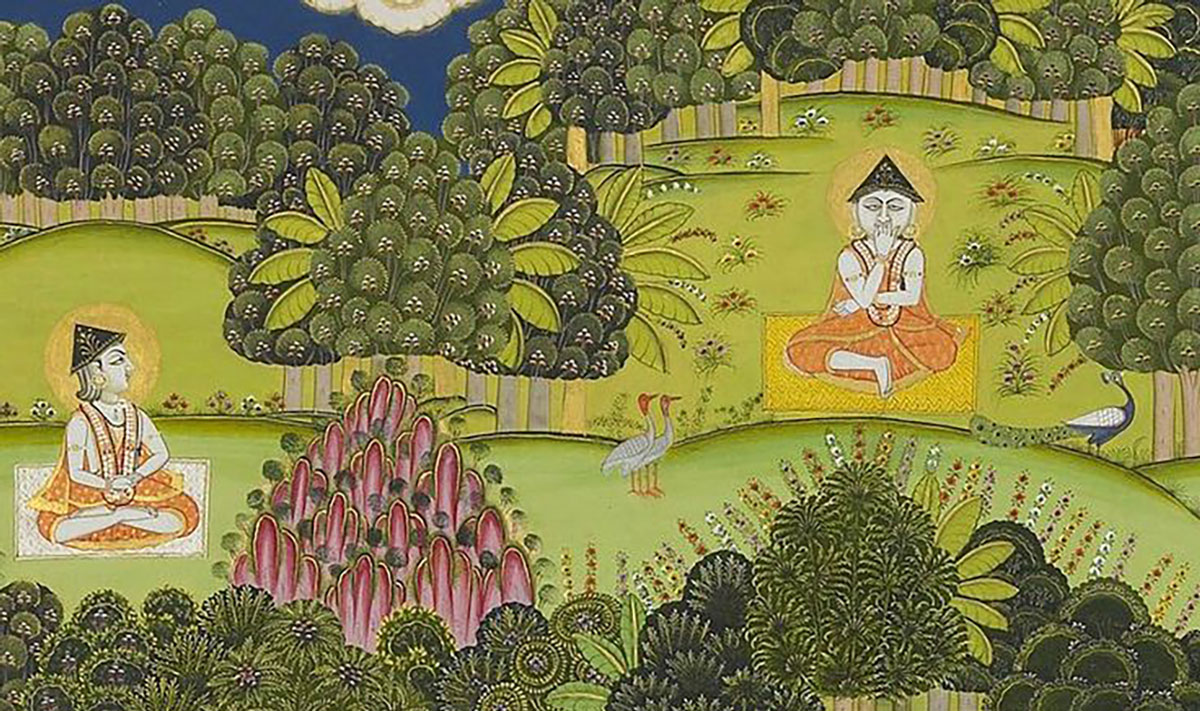
Other verses list seven types of prana, or 'upward breaths', plus seven 'downward breaths' (apana), and seven more that pervade the whole body (vyana).10. An ascetic is portrayed connecting them to his surroundings, from the five material elements (earth, water, fire, wind and space) to the sun, the moon, the stars, the passing seasons and all creatures. Manipulating breath makes him one with the cosmos, and even immortal. Exhalation is also linked to sacrificial offerings (Atharva Veda 15.15-15.18).
The Upanishads build on these themes. "Breath is immortality," a timeless animating presence, says the Brihad-Aranyaka Upanishad (1.6.3).11 The Kaushitaki Upanishad (2.1) turns this around to state: "Brahman is breath," so respiration is communion with the universe.12 The Prashna Upanishad (3.5–3.7) identifies five different aspects of prana, a model later borrowed by yogic texts, which name them "winds" (vayus): "The lower breath (apana) is in the anus and the loins. The breath itself (prana) is established in the eye and the ear, the mouth and the nostrils. The central breath (samana) is in the middle: it makes equal all that is offered as food." The text also highlights a network of thousands of channels (nadis) for vital energy: "In them moves the diffused breath (vyana). Through one of them, the up-breath (udana) rises."13
Modern medical knowledge contradicts this. Although breathing keeps organs alive, it enters the lungs through the nose and throat. However, it can also be felt elsewhere by directing attention to other sensations. The yogi's subtle body is effectively visualised into experience, but ways of doing so are first taught in Tantras a few centuries later.
ASCETIC METHODS
More than 2,000 years ago, texts about dharma (a term associated with duty, law and virtue) said retaining the breath could have purifying powers. Several prescribe pranayama to atone for misconduct. "For destroying all faults it is this which is pre-eminent," declares the Baudhayana Dharmasutra (4.1.30).14 The Manusmriti (6.71) explains how it works: "Just as metals' impurities are burnt up when they are smelted, so faults in the sense organs are burnt up by restraint of the breath."15
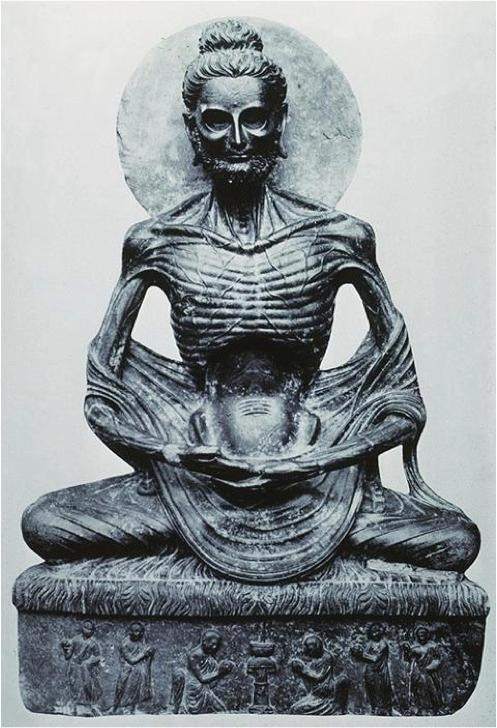
The effect of pranayama is likened to tapas, which means both heat and physical effort that produces it. "Suppressing the breath three times, in accordance with the rules and supplemented by the recitation of the syllable 'Om' and the three Vedic exclamations [bhur, bhuvah and svah, referring to the heavens, the earth and the atmosphere between], should be regarded as a priest's supreme generation of inner heat," says the Manusmriti (6.70).16 Although this text mentions priests, austere forms of tapas were widely practised by ascetics, who renounced Brahmin rituals to seek liberation by themselves. Known collectively as shramanas, meaning "strivers," they included early yogis, Jains and Buddhists.
The Buddha discusses his studies with yogic teachers, who were trying to solve the problem of karma, which means action. According to this doctrine, whose source is unknown, life results in rebirth because whatever people do has karmic outcomes, and the succession of cause and effect spans endless lifetimes. To sever the chain, one had to stop producing karma. Ascetics tried remaining inactive, performing austerities to burn through old stocks. One of these was what the Buddha calls "non-breathing meditation" (Majjhima Nikaya I.243–246).17
His description sounds painful. "Extreme winds slashed my head as if a strong man were attacking my head with a sharp sword," he says, yet he persevered, until "an extreme heat arose in my body; it was as if two strong men were to take a weaker man by the arms and roast him over hot coals." He eventually gave up, noting: "I, indeed, by means of this severe and difficult practice, do not attain to greater excellence in noble knowledge and insight which transcends the human condition. Could there be another path to enlightenment?"18
Critics often warn that breath-control is dangerous. "There is no point in spending a long time cultivating the breaths [or] practising hundreds of breath-retentions, which cause disease," says the 12th-century Amanaska (2.42), which notes the mind can be stilled without exertion: "When [the no-mind state] has arisen, the mighty breath spontaneously and immediately disappears."19 Later teachings acknowledge the risks. "Just as a lion, elephant, or tiger is tamed step by step, so the breath is controlled," says the Hathapradipika (2.15–2.16). "Otherwise it kills the practitioner. Correct pranayama will weaken all diseases. Improper practice of yoga will strengthen all diseases"20
BASIC PRACTICE
In Patanjali's teachings on yoga, pranayama is part of an eightfold yogic method. This starts with guidelines on ethical conduct (yama and niyama) and a stable seated posture (asana). Breath-control promotes an inward focus (pratyahara), preparing the mind for concentration and stillness (via dharana, dhyana and samadhi), in which the inner light of knowledge shines on consciousness alone. Illusions that cover this light can be dissolved by pranayama, which Patanjali calls "external, internal or stopped; regulated according to location, time and number; [and] long and subtle" (2.50).21 The breath is held out or in, or suspended suddenly. Each causes "eruption" (udghata), an upward surge of vital energy.22
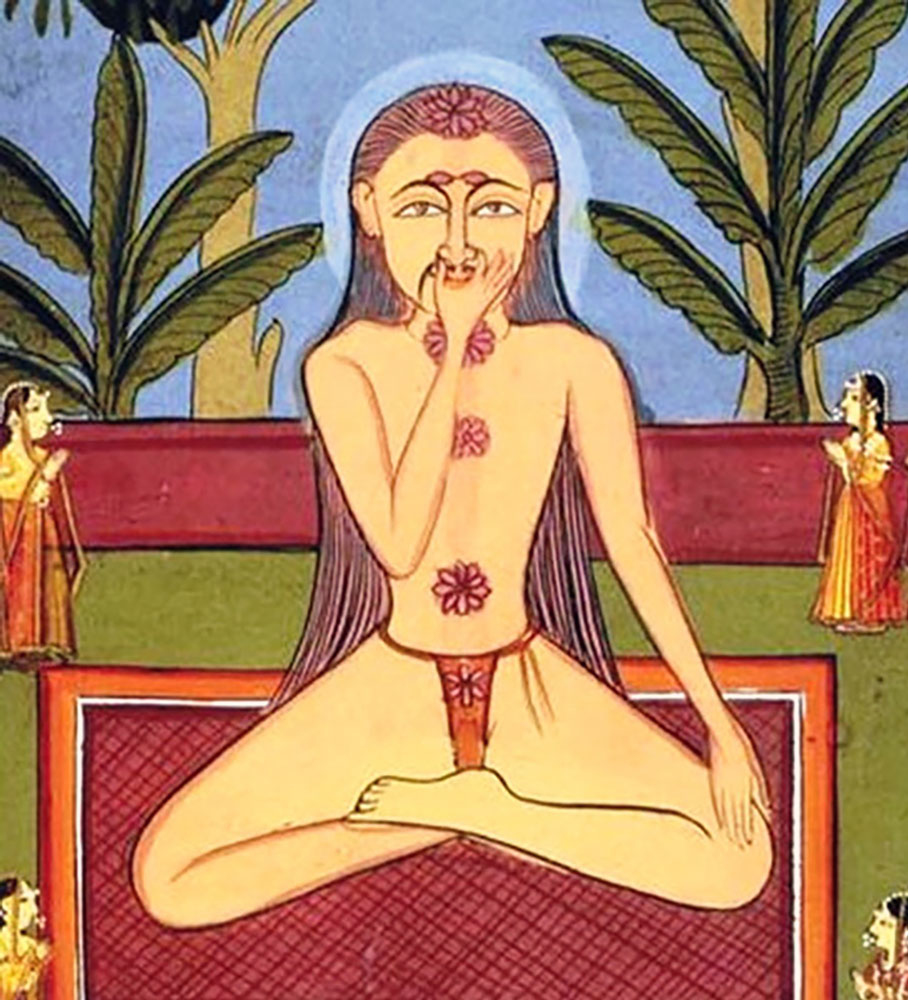
There is also spontaneous breath-control, a mysterious cessation "resulting from limitation of the sphere of activity of inhalation and exhalation, and from gradual conquest of the levels" (2.51).23 Later texts describe a similar phenomenon as kevala kumbhaka, a pure retention "unaccompanied" by breathing. The 13th-century Dattatreyayogashastra (73–74) says it is "mastered as a result of holding one's breath for as long as one likes," after which "there is nothing in the three worlds that is unattainable."24 An accomplished yogi can kill lions and tigers with one blow, while overcoming disease and the need for much sleep (80–83).25
A simpler practice produces these powers, explains the Dattatreyayogashastra (59–66). The yogi "should block the right nostril with the thumb of the right hand and gradually inhale through the left nostril without interruption as deeply as he can. Then he should perform breath-retention." This is sahita kumbhaka, a pause "accompanied" by breathing. "Next he should exhale through the right nostril gently, not forcefully. He should inhale again, through the right nostril, and gently fill his abdomen. After holding [his breath] for as long as he can, he should gently exhale through the left nostril," performing 20 repetitions four times daily: in the morning, at noon, in the evening and at midnight.26
Three months of this purification yields signs of progress: "At first sweat appears. [The yogi] should massage [himself] with it. By slowly increasing, step-by-step, the retention of the breath, trembling arises in the body of the yogi," who hops like a frog. "Through further increase [in the duration] of the practice, levitation arises. Sitting in the lotus position, [the yogi] leaves the ground and remains [in the air] without a support" (75–79).27 Despite these feats, this is preliminary work, preparing the body for subtler practice drawn from Tantras.
TANTRIC INNOVATIONS
Most Tantric systems of yoga have six parts. These are largely the same as Patanjali's eight, but leaving out ethics and substituting reasoning (tarka) for postural guidance. Tantric rituals are usually seated, and often start with purifying breath-control. The earliest known Tantra, the fifth-century Nishvasatattvasamhita (4.110), introduces the phrase "purification of the channels" (nadishuddhi) for alternate-nostril breathing.28 It also uses terms for inhalation (puraka), exhalation (rechaka) and retention (kumbhaka) that later yogic texts adopt.29
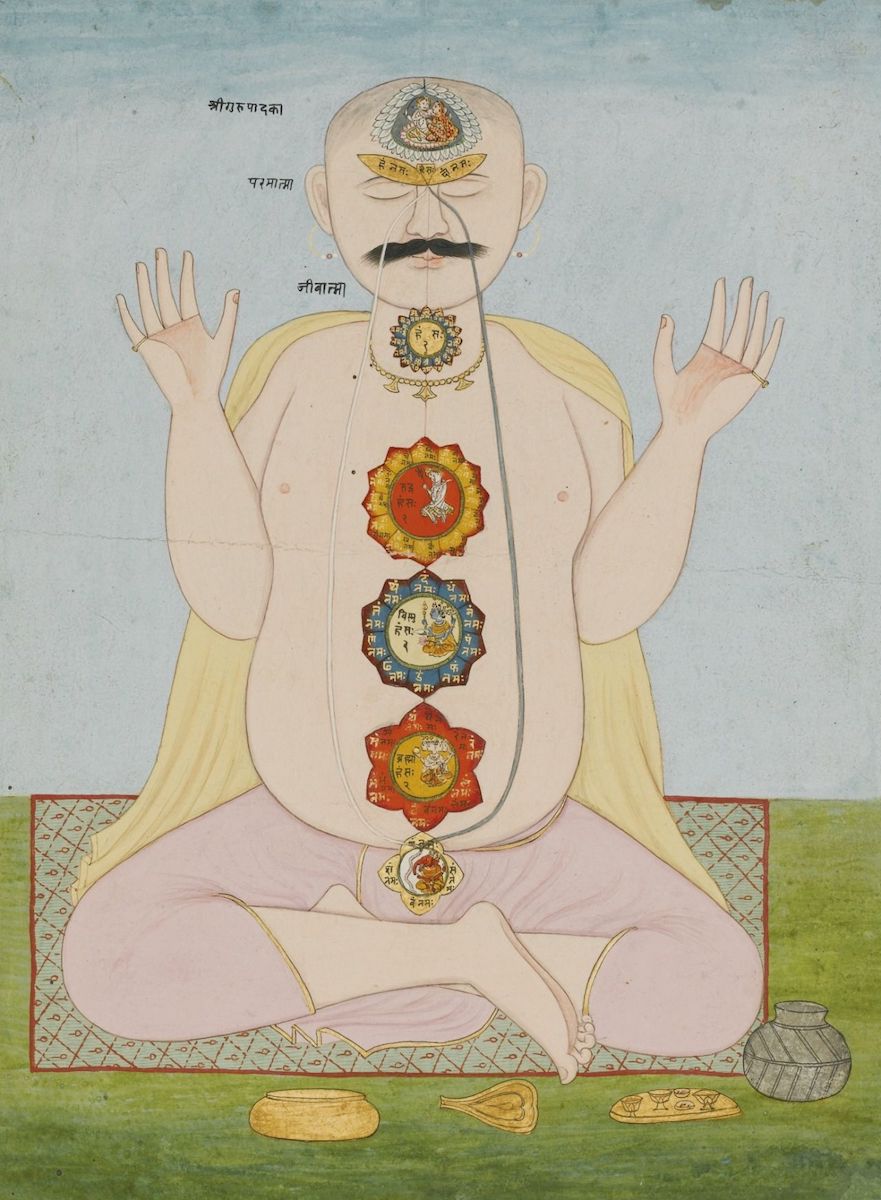
Other Tantras map the subtle yogic body, consisting of channels (nadis), wheels (chakras), knots (granthis) and energy points (marmans). The most common model appears in the 10th-century Kubjikamatatantra (11.34–37), which lists six chakras on the central spinal channel, called Sushumna. They are the mula - or "root" — adhara (at the perineum), svadhisthana (genitals), manipura (navel), anahata (heart), vishuddhi (throat), and ajna (between the eyebrows).30 It also talks about the energetic goddess Kundalini, whose serpent form straightens up through the chakras, dissolving the mind in awakened consciousness.
This process is induced by pranayama. "The fire kindled by the breath continually burns Kundalini," says the 14th-century Yogabija (96–97), which like many yogic texts mixes Tantric ideas with ascetic techniques.31 "Heated by the fire, that goddess […] enters into the mouth of the Sushumna channel in the spine [and] together with the breath and the fire pierces the knot of Brahma," one of three blockages. The others, also named after gods, are called Vishnu and Rudra. Locations vary by text, but each is progressively higher up the spine.
Two other channels are also important. "Ida ends at the left nostril; Pingala is taught to be [the same] on the right," says the 13th-century Vasishthasamhita (28–39). "Know the moon to be in Ida; the sun is said to be in Pingala."32 Breath-control pushes vital energy out of these channels and into Sushumna. The Sanskrit for physical yoga — hatha — means it works "by force."33 Another definition is more esoteric, based on balancing prana in Ida and Pingala to open Sushumna. "The sun is denoted by the syllable ha and the moon by tha," says the Yogabija (148–149). "Because of the union of the sun and moon it is called hathayoga."34
HATHA YOGA
The fire of pranayama is stoked by uniting two more forces: upward-moving prana and descending apana. Their flows are reversed using "locks" (bandhas) and "seals" (mudras), which work with muscular effort and visualisation. The main actions for breath-control involve drawing up the pelvic floor (mulabandha), an abdominal lift (uddiyanabandha) and locking the chin between the collarbones (jalandharabandha). They seal the "pot" (kumbha) of the torso in retentions, combining prana and apana to heat Kundalini.
Generally speaking, says the Hathapradipika (2.45): "Jalandhara is to be done at the end of inhalation. Uddiyana is to be done at the end of [internal] kumbhaka and the beginning of exhalation," with the root lock held throughout.35 If Kundalini ascends the whole spine, it floods the body with nectar (amrita). However, this is a side-effect; the goal is absorption in consciousness, for which pranayama is essential preparation. The Hathapradipika (4.114) concludes: "As long as the moving breath doesn't enter the Sushumna [and] as long as the meditating mind is unlike the natural state, talk of true knowledge is arrogant, deceitful chatter."36
In addition to retentions and alternate-nostril breathing, the Hathapradipika teaches eight pranayama techniques, all labelled kumbhakas. One is commonly heard in modern yoga: ujjayi, a "victorious" closed-throat wheeze. The others are bhastrika, deep "bellows" breathing; bhramari, a "buzzing" hum while exhaling; shitali, a "cooling" inhalation through curled tongue; shitkari, a "whistling" equivalent; suryabheda, "piercing the sun" by breathing into the right nostril and out of the left; murccha, holding the breath to the verge of "fainting"; and plavini, "floating" like a lotus leaf on water.
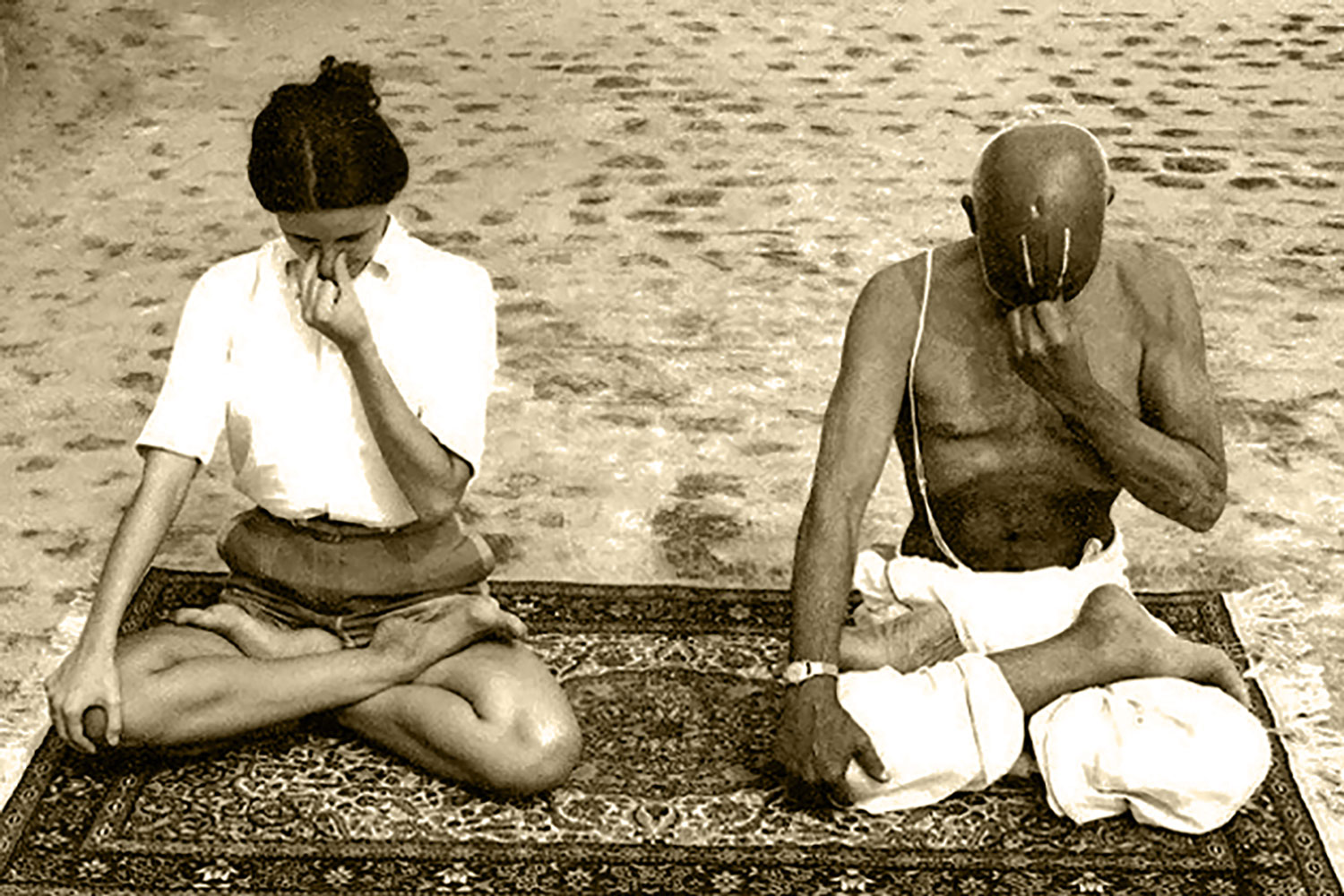
Six preparatory actions (shatkarma) are also taught to cleanse impurities. One involves rapid breathing: kapalabhati, or "shining skull." This is widely seen as breath-control today, having been popularised on Indian TV by the guru Ramdev. A related form of cleansing is the "fire breath" (agnisara or vahnisara), taught in the 18th-century Gherandasamhita (1.19): "Move the navel plexus to the spinal column one hundred times. This gets rid of intestinal diseases and increases the digestive fire."37
Contemporary instructions add more details. Breathing can be paused mid-stream (viloma), or a nostril closed while exhaling (anuloma) or inhaling (pratiloma). There are also variations in rhythm, from equal-length breaths and retentions (samavritti) to irregular patterns (vishamavritti), for which the classic ratio is 1:4:2:1 for inhalation, retention, exhalation and retention.
Chants are sometimes taught as an accompaniment, although few of these appear in yogic texts apart from Om, which encompasses everything. Some Sanskrit syllables are linked to chakras as "seed" or bija mantras. Two others are always recited. "The breath goes out with a ha sound and in with a sa sound. This is the mantra hamsa hamsa. All living beings repeat it," says the Yogabija (146–147). "The repetition is reversed in the central channel and becomes so'ham," or "I am that," a declaration of oneness from the Upanishads.38
Modern teachers also hint at longevity. In Light on Yoga, B.K.S. Iyengar says: "The yogi's life is not measured by his days, but by the number of his breaths."39 However, he stops short of saying pranayama "postpones old age," musing: "Why worry about it? Death is certain."40 His cautious tone reflects a general wariness today of teaching breath-control. Describing one technique as "fraught with danger," Iyengar warns: "do not practise it on your own without the personal supervision of an experienced guru.41.
Although it is wise to build up slowly, taking care to avoid putting the body under strain, being mindful of breathing is a helpful practice in itself. "Through the breath, we develop an awareness of the subtle force within the body," notes the Bihar School of Yoga's pranayama book, "and directing the mind to become aware of the subtle activities is the beginning of yoga."42
REFERENCES
Akers, Brian. 2002. The Hatha Yoga Pradipika. Woodstock: YogaVidya.com.
Doniger, Wendy. 1981. The Rig Veda. London: Penguin Classics.
Doniger, Wendy and Brian Smith. 1991. The Laws of Manu. London: Penguin Classics.
Ganguli, Kisari Mohan. 1891. The Mahabharata of Krishna-Dwaipayana Vyasa, Translated into English Prose, Çanti Parva, vol. 2. Calcutta: Bharata Press.
Iyengar, B.K.S. 1966. Light on Yoga. London: George Allen & Unwin.
———. 1983. Light on Pranayama. London: Unwin Paperbacks.
———. 2005. Light on Life. London: Rodale.
Mallinson, James. 2004. The Gheranda Samhita. Woodstock: YogaVidya.com.
Mallinson, James and Mark Singleton. 2017. Roots of Yoga. London: Penguin Classics.
Olivelle, Patrick. 1998. The Early Upanishads. Oxford: Oxford University Press.
Roebuck, Valerie. 2000. The Upanishads. London: Penguin Classics.
Saraswati, Niranjanananda. 2009. Prana and Pranayama. Munger: Yoga Publications Trust.
Sargeant, Winthrop. 2009. The Bhagavad Gita. Albany: SUNY Press.
Whitney, William. 1905. The Atharva-Veda Samhita. Cambridge: Harvard University.
Further Reading
Daniel Simpson teaches yoga philosophy for the Oxford Centre for Hindu Studies. He has an M.A. in Traditions of Yoga and Meditation from SOAS, University of London. ↩
James Mallinson and Mark Singleton, Roots of Yoga (Penguin Classics, 2017), p.138. ↩
Kisari Mohan Ganguli, The Mahabharata (Bharata Press, 1891), p.604. ↩
Winthrop Sargeant, The Bhagavad Gita (SUNY Press, 2009), p.269. ↩
Mallinson and Singleton, Roots of Yoga, p.140. ↩
Mallinson and Singleton, Roots of Yoga, p.142. ↩
Mallinson and Singleton, Roots of Yoga, p.142. ↩
Wendy Doniger, The Rig Veda (Penguin Classics, 1981), pp.137–138. ↩
William Whitney, Atharva-Veda Samhita (Harvard University, 1905), pp.632–633. ↩
Mallinson and Singleton, Roots of Yoga, p.137. ↩
Valerie Roebuck, The Upanishads (Penguin Classics, 2000), p.251. ↩
Patrick Olivelle, The Early Upanishads (Oxford University Press, 1998), p.333. ↩
Roebuck, The Upanishads, p.337. ↩
Mallinson and Singleton, Roots of Yoga, p.140. ↩
Mallinson and Singleton, Roots of Yoga, p.140. ↩
Wendy Doniger and Brian Smith, The Laws of Manu (Penguin Classics, 1991), p.124. ↩
Mallinson and Singleton, Roots of Yoga, p.138. ↩
Mallinson and Singleton, Roots of Yoga, pp.138-139. ↩
Mallinson and Singleton, Roots of Yoga, p.41. ↩
Brian Akers, Hatha Yoga Pradipika (YogaVidya.com, 2002), pp.36–37. ↩
Mallinson and Singleton, Roots of Yoga, p.140. ↩
Mallinson and Singleton, Roots of Yoga, p.141. ↩
Mallinson and Singleton, Roots of Yoga, p.141. ↩
Mallinson and Singleton, Roots of Yoga, p.156. ↩
Mallinson and Singleton, Roots of Yoga, p.156. ↩
Mallinson and Singleton, Roots of Yoga, pp.155–156. ↩
Mallinson and Singleton, Roots of Yoga, p.156. ↩
Mallinson and Singleton, Roots of Yoga, p.144. ↩
Mallinson and Singleton, Roots of Yoga, p.485, n.21. ↩
Mallinson and Singleton, Roots of Yoga, p.204. ↩
Mallinson and Singleton, Roots of Yoga, p.215. ↩
Mallinson and Singleton, Roots of Yoga, p.195. ↩
Mallinson and Singleton, Roots of Yoga, p.5. ↩
Mallinson and Singleton, Roots of Yoga, p.32. ↩
Akers, Hatha Yoga Pradipika, p.44. ↩
Akers, Hatha Yoga Pradipika, p.113. ↩
Mallinson, The Gheranda Samhita (YogaVidya.com, 2004), p.5. ↩
Mallinson and Singleton, Roots of Yoga, p.32. ↩
B.K.S. Iyengar, Light on Yoga (George Allen & Unwin, 1966), p.43. ↩
B.K.S. Iyengar, Light on Life (Rodale, 2005), p.104. ↩
B.K.S. Iyengar, Light on Pranayama (Unwin Paperbacks, 1983), p.120. ↩
Niranjanananda Saraswati, Prana and Pranayama (Yoga Publications Trust, 2009), p.6. ↩
